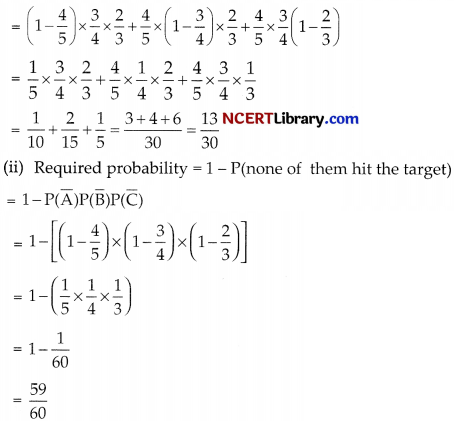Practicing the CBSE Sample Papers for Class 12 Maths with Solutions Set 2 allows you to get rid of exam fear and be confident to appear for the exam.
CBSE Sample Papers for Class 12 Maths Set 2 with Solutions
Time : 3 Hours
Maximum Marks: 80
General Instructions :
- This question paper contains five sections – A. B. C. D and E. Each section is compulsory. However, there are internal choices in some questions.
- Section – A has 18 MCQ’s and 02 Assertion-Reason based questions of 1 mark each.
- Section – B has 5 Very Short Answer (VSA)-type questions of 2 marks each.
- Section – C has 6 Short Answer (SA)-type questions of 3 marks each.
- Section – D has 4 Long Answer (LA)-type questions of 5 marks each.
- Section – E has 3 source based/case based/passage based/integrated units of assessment (4 marks each) with sub parts.
Section – A
(Multiple Choice Questions)
Each question carries 1 mark
Question 1.
The set of all 2 x 2 matrices which is commutative with the matrix

with repect to matrix multiplication is:
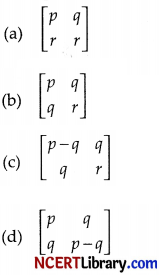
Answer:

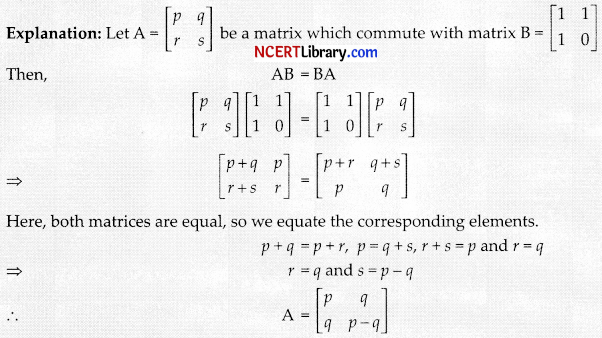
Question 2.
The value of

Answer:
(a) 1
(b) \(\frac{\sqrt{3}}{2}\)
(c) \(\frac { 1 }{ 2 }\)
(d) None of these
Answer:
(b) \(\frac{\sqrt{3}}{2}\)
Explanation:

= cos2 15° – sin215°
= cos2 x 15° (∵ cos2 θ – sin2 θ = cos 2θ)
= cos 30°
= \(\frac{\sqrt{3}}{2}\)
![]()
Question 3.
ABCD is a rhombus whose diagonals intersect at E.
Then, \(\vec{EA}\) + \(\vec{EB}\) + \(\vec{EC}\) + \(\vec{ED}\) equals:
(a) \(\vec{0}\)
(b) \(\vec{AD}\)
(c) 2\(\vec{BC}\)
(d) 2\(\vec{AD}\)
Answer:
(a) \(\vec{0}\)
Explanation: In a rhombus, diagonal bisect each other.
∴|\(\vec{ED}\)| = |\(\vec{EB}\)| and |\(\vec{EC}\)| = |\(\vec{EA}\)|
Since, they are opposite to each other.
∴ They are of opposite sign
∴ \(\vec{ED}\) = – \(\vec{EB}\) and \(\vec{EC}\) = – \(\vec{EA}\)
\(\vec{ED}\) + \(\vec{EB}\) = 0 and \(\vec{EC}\) + \(\vec{EA}\) = 0
Hence,
\(\vec{EA}\) + \(\vec{EB}\) + \(\vec{EC}\) + \(\vec{ED}\) = 0
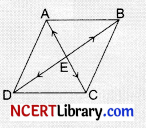
Question 4.
If y = \(\sqrt{3 x+2}\) + \(\frac{1}{\sqrt{2 x^2+4}}\) then \(\frac { dy }{ dx }\) is equal to:
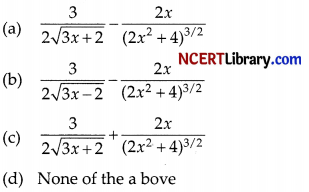
Answer:
![]()
Explanation: Let
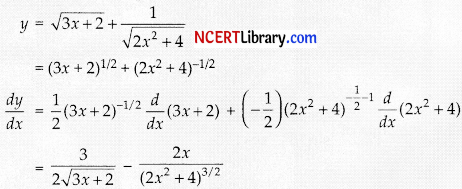
Question 5.
By the inspection method, evaluate ∫(au2 + bu + C) du
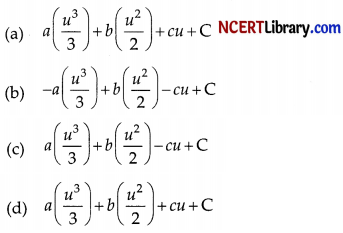
Answer:


Question 6.
The number of solutions of \(\frac { dy }{ dx }\) = \(\frac { y+1 }{ x-1 }\), when y(1) = 2 is:
(a) none
(b) one
(c) two
(d) infinite
Answer:
(b) one
Explanation:
\(\frac { dy }{ dx }\) = \(\frac { y+1 }{ x-1 }\)
⇒\(\frac { dy }{ y+1 }\) = \(\frac { dx }{ x-1 }\)
On integrating both sides, we get
log (y+1) = log (x-1) – log c
⇒ C(y+1) = x – 1
C = \(\frac { x-1 }{ y+1 }\)
when x = 1 and y = 2, then C = 0
So, the required solution is x – 1 = 0.
Here, only one solution exist.
![]()
Question 7.
The optimal value of the objective function is attained at the points.
(a) corner points of the feasible region
(b) any poiny of the feasible region
(c) on x-axis
(d) on y-axis
Answer:
(a) corner points of the feasible region
Explanation: By putting the corner points in objective function, we get the optimal vali.
Question 8.
The components of \(\hat{i}\) in the direction of the vector \(\hat{i}\) + \(\hat{j}\) + 2\(\hat{k}\) is:
(a) \(\sqrt{6}\)
(b) 6
(c) 6\(\sqrt{6}\)
(d) \(\frac{\sqrt{6}}{6}\)
Answer:
(d) \(\frac{\sqrt{6}}{6}\)
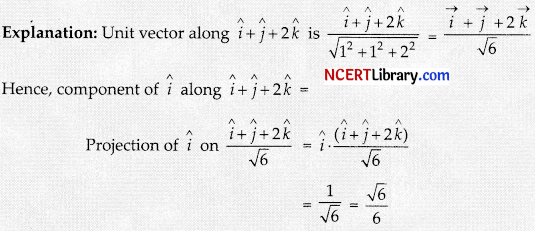
Question 9.
∫\(\frac{1}{\log x^e}\) dx =
(a) log logx e + C
(b) \(\frac{1}{\left(\log _x e\right)^2}\) + C
(c) x log \(\frac { x }{ e }\) + C
(d) None of these
Answer:
(c) x log \(\frac { x }{ e }\) + C
Explanation:
∫\(\frac{1}{\log x^e}\) = ∫loge x dx
=∫1.loge x dx = loge x . x – ∫\(\frac { 1 }{ x }\) . x dx
= x loge x – x + C
= x (loge x – 1) + C
= x (loge x – logloge e) + C
= x logloge (\(\frac { x }{ e }\)) + C
Question 10.
If A and B are square matrices of same order and AB = 3I, then A-1 is equal to:
(a) 3B
(b) \(\frac { 1 }{ 3 }\)B
(c) 3B-1
(d) \(\frac { 1 }{ 3 }\)B-1
Answer:
(b) \(\frac { 1 }{ 3 }\)B
Explanation: AB = 3I
\(\frac { 1 }{ 3 }\) (AB) = I
A(\(\frac { 1 }{ 3 }\)B) = I
A-1 = \(\frac { 1 }{ 3 }\) B
Question 11.
Let Z = ax + by is a linear objective function, variables x and y are called ………… variables.
(a) independent
(b) continuous
(c) decision
(d) dependent
Answer:
(c) decision
Explanation:
Explanation: A2 = I
Then A . A = I
or A-1(A. A) = A-1 I
⇒ (A-1. A)A = A-1 I
⇒ IA = A-1
⇒ A-1 = A
![]()
Question 13.
If 
then the value of x is:
(a) ±2
(b) ±3
(c) ±6
(d) 0
Answer:
(c) ±6
Explanation:

⇒x2 – 36 = 36 – 36
⇒x2 – 36 = 0
⇒ x = ±6
Question 14.
Two events E and F are independent if P(E) = 0.3 and P(E ∪ F) = 0.5, then P(\(\frac { E }{ F }\)) – P(\(\frac { F }{ E }\)) is equal to:
(a) \(\frac { 2 }{ 7 }\)
(b) \(\frac { 3 }{ 35 }\)
(c) \(\frac { 1 }{ 70 }\)
(d) \(\frac { 1 }{ 7 }\)
Solution:
(c) \(\frac { 1 }{ 70 }\)
Explanation: Here, P(E) = 0.3 and P(E ∪ F) = 0.5
Let P(F) = x
∵ P(E ∪ F) = P(E) + P(F) – P(E ∩ F)
P(E) + P(F) – P(E).P(F)
0.5 = 0.3 + x – 0.3x
x = \(\frac { 0.5 – 0.3 2 }{ 0.7 }\) = \(\frac { 2 }{ 7 }\) = P(F)
P(\(\frac { E }{ F }\)) – P(\(\frac { F }{ E }\)) = (\(\frac { P(E ∩ F) }{ p(F) }\)) – (\(\frac { P(F ∩ E) }{ p(E) }\))
= \(\frac{P(E \cap F) \cdot P(E)-P(F \cap E) \cdot P(F)}{P(E) \cdot P(F)}\)
= \(\frac{\mathrm{P}(\mathrm{E} \cap \mathrm{F})[\mathrm{P}(\mathrm{E})-\mathrm{P}(\mathrm{F})]}{\mathrm{P}(\mathrm{E}) \cdot \mathrm{P}(\mathrm{F})}\)
= \(\frac{P(E \cap F)[P(E)-P(F)]}{P(E \cap F)}\)
= P(E) – P(F)
= \(\frac { 3 }{ 10 }\) – \(\frac { 2 }{ 7 }\) = \(\frac { 21 – 20 }{ 70 }\) = \(\frac { 1 }{ 70 }\)
![]()
Question 15.
Which of the following is a homogeneous differential equation?
(a) (4x + 6y + 5)dy – (3y + 2x + 4) dx = 0
(b) xy dx – (x3 + y3)dx = 0
(c) (x3 + 2y2)dx + 2xy dy = 0
(d) y2dx + (x2 – xy – y2)dy = 0
Answer:
(d) y2dx + (x2 – xy – y2)dy = 0
Explanation: By equation y2dx + (x2 – xy – y2)dy = 0
\(\frac { dy }{ dx }\) = \(\frac{y^2}{x^2-x y-y^2}\)
Power of numerator and denominator are same order. Hence, it is a homogeneous differential equation.
Question 16.

is continuous at x = \(\frac { π }{ 2 }\), then
(a) m = 1, n = 0
(b) m = \(\frac { nπ }{ 2 }\) + 1
(c) n = \(\frac { mπ }{ 2 }\)
(d) m = n = \(\frac { π }{ 2 }\)
Answer:
(c) n = \(\frac { mπ }{ 2 }\)
Explanation: We have,
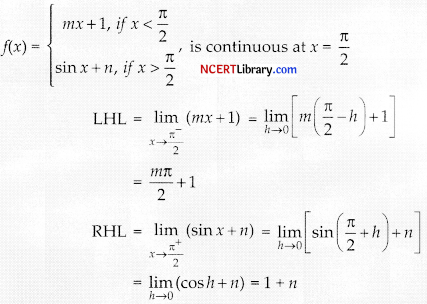
We must have, LHL = RHL
\(\frac { mπ }{ 2 }\) + 1 = n + 1
n = \(\frac { mπ }{ 2 }\)
![]()
Question 17.
if (2\(\hat{i}\) + 6\(\hat{j}\) + 27\(\hat{k}\)) x (\(\hat{i}\) + p\(\hat{j}\) + q\(\hat{k}\)) = \(\vec{0}\) then the value of p and q are:
(a) p = 6, q = 27
(b) p = 3, q = \(\frac { 27 }{ 2 }\)
(c) p = 6, q = \(\frac { 27 }{ 2 }\)
(d) p = 3, q = 27
Answer:
(b) p = 3, q = \(\frac { 27 }{ 2 }\)
Explanation:
(2\(\hat{i}\) + 6\(\hat{j}\) + 27\(\hat{k}\)) x (\(\hat{i}\) + p\(\hat{j}\) + q\(\hat{k}\)) = \(\vec{0}\)
so, (2\(\hat{i}\) + 6\(\hat{j}\) + 27\(\hat{k}\)) is parilel to (\(\hat{i}\) + p\(\hat{j}\) + q\(\hat{k}\))
\(\frac { 2 }{ 1 }\) = \(\frac { 6 }{ p }\) = \(\frac { 27 }{ q }\)(. d.r’s of parallel vectors are
\(\frac { 2 }{ 1 }\) = \(\frac { 6 }{ p }\) and \(\frac { 2 }{ 1 }\) = \(\frac { 27 }{ q }\)
p – 3 and q = \(\frac { 27 }{ 2 }\)
Question 18.
Any three numbers which are proportional to the direction cosines of a line are calleth
(a) direction angles
(b) direction ratios
(c) another set of direction cosines
(d) none of these
Answer:
(b) direction ratios
Explanation:
Any three numbers which are proportional to the direction cosines of a line are called direction ratios of the line. If l, m and n are direction cosines and a, b and c are direction ratios of a line, then a = λl, b = λm, c = λn for any non-zero, λ ∈ R.
Assertion-Reason Based Question
In the following questions, a statement of assertion (A) is followed by a statement of Reason (R).
Choose the correct answer out of the following choices.
(a) Both A and R are true and R is the correct explanation of A.
(b) Both A and R are true hut R is not the correct explanation of A.
(c) A is true but R is false.
(d) A is false hut R is true.
![]()
Question 19.
Assertion (A): sin-1 (sin 3) = 3
Reason (R): For principal values sin-1 (sin x) = x
Answer:
(d) A is false but R is true.
Explanation:
∵ 3 ≈ 171° (lies in IInd quadrant)
∴ sin-1 (sin3) = 3 – π ≠ 3
But sin-1 (sin x) = x for principal values
Question 20.
Assertion (A): |\(\vec{a}\)| = |\(\vec{b}\)|does not implies that \(\vec{a}\) = \(\vec{b}\)
Reason (R) : If \(\vec{a}\) = \(\vec{b}\),then \(\vec{a}\) . \(\vec{b}\) = |\(\vec{a}\)|2 = |\(\vec{b}\)|2
Answer:
(b) Both A and R are true but R is not the correct explanation of A.
Explanation:
If \(\vec{a}\) = \(\vec{b}\) then |\(\vec{a}\)| = |\(\vec{b}\)|
∴\(\vec{a}\) . \(\vec{b}\) = \(\vec{a}\) . \(\vec{a}\) = |\(\vec{a}\)|2
and \(\vec{a}\) . \(\vec{b}\) = \(\vec{b}\) . \(\vec{b}\) = |\(\vec{b}\)|2
∴\(\vec{a}\) . \(\vec{b}\) = |\(\vec{a}\)|2 = |\(\vec{b}\)|2
Suppose, if
\(\vec{a}\) = a1\(\hat{i}\) + a2\(\hat{j}\)
Then,
|\(\vec{a}\)| = |a1\(\hat{i}\) + a2\(\hat{j}\)|
= |a1\(\hat{i}\) – a2\(\hat{j}\)|
= |- a1\(\hat{i}\) + a2\(\hat{j}\)|
= |- a1\(\hat{i}\) – a2\(\hat{j}\)|
Hence, |\(\vec{a}\)| = |\(\vec{b}\)|
does, not implies that \(\vec{a}\) = \(\vec{b}\)
Section – B
This section comprises of very short answer type-questions (VSA) of 2 marks each
Question 21.
Using principal values, find the value of cos-1 (cos\(\frac { 13π }{ 6 }\))
OR
If R = {(x,y) : x + 2y = 8} is a relation on N, then what is the range of R.
Solution:
As principal value of cos-1 is [0, π]
∴ cos-1(cos\(\frac { 13π }{ 6 }\)) = cos-1 [ cos(2π + \(\frac { π }{ 6 }\))]
= cos-1(cos\(\frac { π }{ 6 }\)) [∵ cos (2π + θ) = cos θ]
= \(\frac { π }{ 6 }\) ∈ [0,π]
∴ cos-1 (cos\(\frac { 13π }{ 6 }\)) = \(\frac { π }{ 6 }\)
OR
The given relation on N is
R={(x,y) : x + 2y = 8}
Since, both x, y ∈ N
x can take value
2, 4, 6 for all x, y ∈ N.
For x = 2, 2 + 2y = 8
⇒ y = 3
For x = 4, 4 + 2y = 8
⇒ y = 2
For x = 6,
⇒ y = 1
⇒ R = {(2, 3) (4, 2), (6, 1)}
Range of R = Set of second elements
= {1, 2, 3}
![]()
Question 22.
A balloon, which always remains spherical has a variable diameter \(\frac { 3 }{ 2 }\) (2x + 3). What is the rate of change of volume with respest to x.
Solution:
Let V be the volume of the balloon.
Radius of spherical balloon, r = \(\frac { 3 }{ 4 }\) (2x + 3)
Since, V = \(\frac { 4π }{ 3 }\) (r)3
\(\frac { 4π }{ 3 }\) {\(\frac { 3 }{ 4 }\) (2x + 3)}3 = \(\frac { 9π }{ 16 }\) (2x + 3)3
On differentiating V w.r.t.x, we get
\(\frac { dV }{ dx }\) = \(\frac { 9π }{ 16 }\) x 3 (2x + 3)3 \(\frac { d }{ dx }\) (2x + 3)
= \(\frac { 27π }{ 8 }\) (2x + 3)2
Question 23.
The equations of a line are 5x – 3 = 15y + 7 = 3 – 10 z. Write the direction cosines of the line.
OR
What is the equation of the line through the point \(\hat{i}\) – 2\(\hat{j}\) + \(\hat{k}\) and 3\(\hat{j}\) – 2\(\hat{k}\)?
Solution:
Given line is : 5x – 3 = 15y + 7 = 3 – 10z
Rewritting the equation in standard form:
5 (x – \(\frac { 3 }{ 5 }\)) = 15 (y + \(\frac { 7 }{ 15 }\)) = -10 (z – \(\frac { 3 }{ 10 }\))
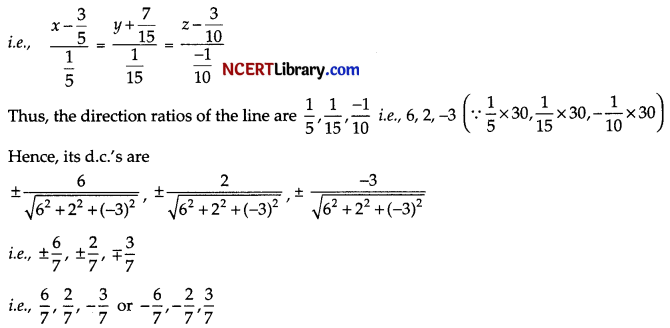
OR
Let \(\vec{a}\) = \(\hat{i}\) – 2\(\hat{j}\) + \(\hat{k}\)
\(\vec{b}\) = 3\(\hat{j}\) -2 \(\hat{k}\)
Hence, the equation of line is
\(\vec{r}\) = \(\vec{a}\) + λ(\(\vec{b}\) – \(\vec{a}\))
= (\(\hat{i}\) – 2\(\hat{j}\) + \(\hat{k}\)) + λ ( – \(\hat{i}\) + 5\(\hat{j}\) – 3\(\hat{k}\))
= (1 – λ) \(\hat{i}\) + (5λ – 2) \(\hat{j}\) + (1 – 3λ) \(\hat{k}\)
![]()
Question 24.
Find the solution of differential equation \(\frac { dy }{ dx }\) + \(\frac { y }{ x }\) = sin x.
Solution:
Given, differential equation is,
\(\frac { dy }{ dx }\) + \(\frac { y }{ x }\) = sin x.
which is a linear differential equation.
Hence, P = \(\frac { 1 }{ x }\) and Q = sin x
![]()
The general solution is,
y. x = ∫x. sin x dx + C ………………(i)
Take, I = ∫ x . sin x dx
= – x cos x – ∫ – cos x dx
= – x cos x + sin x
Put in (i), we get
yx = – x cos x + sin x + C
⇒ x (y + cosx) sin x + C
Question 25.
Find λ if,
(2\(\hat{i}\) + 6\(\hat{j}\) + 14\(\hat{k}\)) x (\(\hat{i}\) – λ\(\hat{j}\) + 7\(\hat{k}\)) = o
Solution:
(2\(\hat{i}\) + 6\(\hat{j}\) + 14\(\hat{k}\)) x (\(\hat{i}\) – λ\(\hat{j}\) + 7\(\hat{k}\)) = o

∴\(\hat{i}\) (42 + 14λ) – \(\hat{j}\)(14 – 14) + \(\hat{k}\) (- 2λ – 6) = 0
\(\hat{i}\) (42 + 14λ) + \(\hat{k}\) ( – 2λ – 6) = o\(\hat{i}\) + o\(\hat{j}\) + o\(\hat{k}\)
Comparing coefficients \(\hat{i}\) and \(\hat{k}\) on both sides, we get
42 + 14λ = 0
⇒ 14λ = – 42
λ = – 3
and – 2λ – 6 = 0
⇒ – 2λ = 6
⇒ λ = – 3
Section – C
This section comprises of short answer type questions (SA) of 3 marks each
Question 26.
Evaluate: ∫\(\frac{e^x}{\sqrt{5-4 e^x-e^{2 x}}}\). dx
Solution:
We have ∫\(\frac{e^x}{\sqrt{5-4 e^x-e^{2 x}}}\). dx
Put ex = t
On differentiating both sides,
ex dx = dt
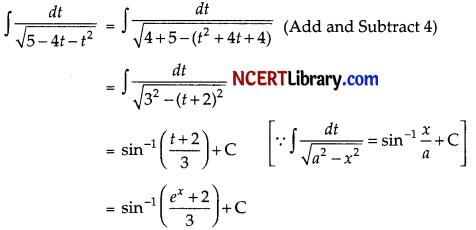
Question 27.
Ram can find a solution of 60% of the problems given in mathematics examination paper and Shyam can find out 80% of it. What is the probability that at least one of them will solve the problem that is selected at random?
OR
An electronic assembly consists of two sub-systems say A and B. From previous testing procedures, the following probabilities are assumed be known.
P(A fails) = 0.2
P(B fails alone) = 0.15
P(A and B fail) = 0.15
Evaluate the following probabilities
(i) P(A) fails given that B has failed
(ii) P(A) fails alone
Solution:
Let us consider the events:
A = Ram finds the solution
B = Shyam find the solution
Since, A and B are independent events
So, P(A) = \(\frac { 60 }{ 100 }\) = \(\frac { 3 }{ 5 }\) and P(B) = \(\frac { 80 }{ 100 }\) = \(\frac { 4 }{ 5 }\)
∴Required probability = P(A ∪ B)
= P(A) + P(B) – P(A ∩B)
= P(A) + P(B) – P(A).P(B) [∵P(A ∩ B) = P(A).P(B)]
= \(\frac { 3 }{ 5 }\) + \(\frac { 4 }{ 5 }\) – \(\frac { 3 }{ 5 }\) x \(\frac { 4 }{ 5 }\) = \(\frac { 7 }{ 5 }\) – \(\frac { 12 }{ 25 }\) = \(\frac { 23 }{ 25 }\)
OR
Let, the events in which A fails and B fails be doneted by EA and EB respectively.
Then, P(EA) = 0.2
P(EA and EB) = 0.15
P(B fails alone) = P(EB) – P(EA and EB)
0.15 = P(EB) – 0.15
P(EB) = 0.15 + 0.15 = 0.3
(i) P(\(\frac{E_A}{E_B}\)) = \(\frac{\mathrm{P}\left(\mathrm{E}_{\mathrm{A}} \cap \mathrm{E}_{\mathrm{B}}\right)}{\mathrm{P}\left(\mathrm{E}_{\mathrm{B}}\right)}\)
= \(\frac { 0.15 }{ 0.3 }\) = 0.5
(ii) P (A fails alone) = P(EA) – P(EA and EB)
= 0.2 – 0.15
= 0.05
![]()
Question 28.
Find the particular solution, satisfying given condition, for the following differential equation:
\(\frac { dy }{ dx }\) – \(\frac { y }{ x }\) + cosec \(\frac { y }{ x }\) = 0; y = 0 When x = 1
OR
Find the particular solution of the following differential equation:
xy \(\frac { dy }{ dx }\) = (x + y)(y + 2) : y = 1 when x = 1
Solution:
Given differential equation is
\(\frac { dy }{ dx }\) – \(\frac { y }{ x }\) + cosec \(\frac { y }{ x }\) = 0 ………….(i)
Put \(\frac { y }{ x }\) = t ⇒ y = xy
Differentiating both sides w.r.t. x, we get
\(\frac { dy }{ dx }\) = x \(\frac { dt }{ dx }\) + t
Put in equation (i),
x \(\frac { dt }{ dx }\) + t – t + cosec t = 0
x \(\frac { dt }{ dx }\) = – cosec t
x \(\frac { dt }{ dx }\) = – \(\frac { 1 }{ sint }\)
sin t dt = – \(\frac { dx }{ x }\)
On integrating both sides, we get
⇒ – cos t = – log x + C
log x – cos t = C
⇒ log x – cos (\(\frac { y }{ x }\)) = C, ……….(ii) [∵t = \(\frac { y }{ x }\)]
When y = 0 and x = 1
log 1 – cos 0 = C
∴ C = – 1
Put the value of C in equation (ii),
log x – cos (\(\frac { y }{ x }\)) = – 1
⇒log x + 1 = cos (\(\frac { y }{ x }\))
⇒log x + log e = cos (\(\frac { y }{ x }\))
⇒log |xe| = cos (\(\frac { y }{ x }\))
OR
Given differential equation is:
xy \(\frac { dy }{ dx }\) = (x + 2)(y + 2)
⇒ \(\frac { y }{ y + 2 }\) dy = \(\frac { x + 2 }{ x }\) dx
On integrating both sides, we get
∫\(\frac { y }{ y + 2 }\) dy = ∫\(\frac { x + 2 }{ x }\) dx …………….(i)
Put y + 2 = t ⇒ y = t – 2
Differentiating w.r.t.y
1 = \(\frac { dt }{ dy }\)
⇒ dy = dt
Equation (i) becomes
∫\(\frac { t-2 }{ t }\) dt = ∫1dx + 2∫\(\frac { dx }{ x }\) dx
⇒ ∫(1 – \(\frac { 2 }{ t }\)) dt = x + 2 logx + C
⇒ t – 2log t = x + 2 log x + C
y + 2 – 2log(y + 2) = x + 2 log x + C
When x = 1, y = – 1
– 1 + 2 – 2log 1 = 1 + 2 log 1 + C
⇒ 1 = 1 + C ⇒ C = O
Equation (ii) becomes
y + 2 – 2log(y + 2) = x + 2logx
Which is the particular solution of the given differential equation.
Question 29.
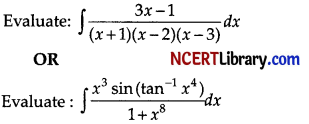
Solution:
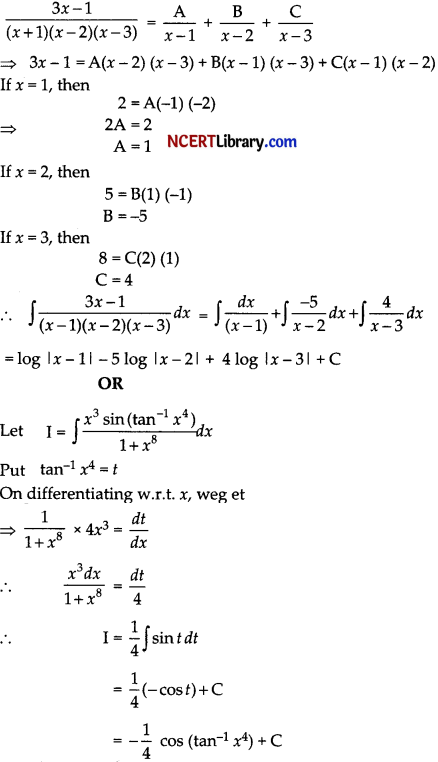
Question 30.
Solve the following LPP graphically:
Minimize, Z = 5x + 10y
Subject to constraints x + 2y ≤ 120
x + y ≥ 60
x – 2y ≥ 0
and x, y ≥ 0
Solution:
Minimize, Z = 5x + 10y
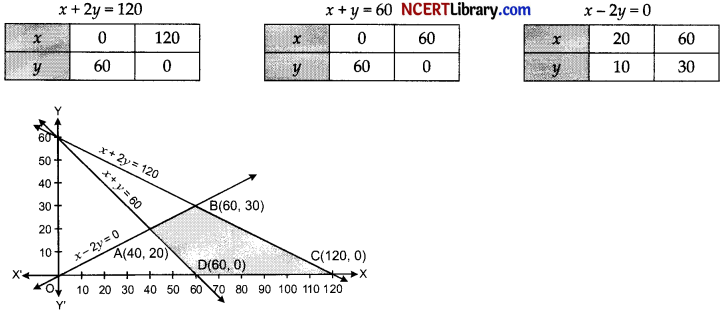
The shaded region ABCDA represented by the given constraints is the feasible region. Corner points of the common shaded region are A(40, 20), B(60, 30), C(120, O) and D(60, 0). Value of Z at each comer point is given as:

Hence, minimum value of Z is 300 at (60, 0).
Question 31.
Find ∫cos 2x cos 4x cos 6x dx
Solution:
Let
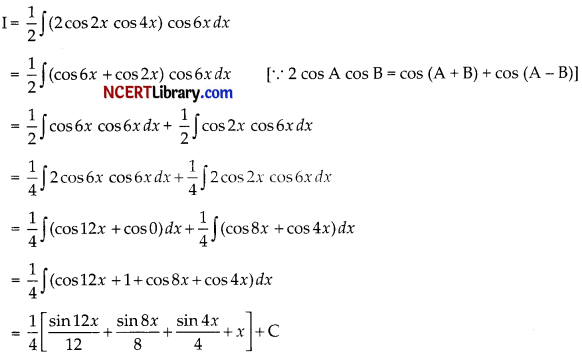
Section – D
This section comprises of long answer type questions (LA) of 5 marks each
Question 32.
Usina integration find the area of the region bounded by the triangle whose vertices are (1, 3) (2, 5) and (3,4).
Solution:
Let A(1, 3), 8(2, 5) and C(3, 4) are the vertices of ∆ABC.
Equation of ime AB:
y – 3 = \(\frac { 5 – 3 }{ 2 – 1 }\) ( x – 1)
⇒ y – 3 = 2(x – 1)
⇒ 2x – 2 = y – 3
⇒ 2x – y = (- 1)
⇒ y = 2x + 1 ………………..(i)
Equation of line BC:
y – 5 = \(\frac { 4 – 5 }{ 3 – 2 }\) ( x – 2)
⇒ y – 5 = – 1(x – 2)
⇒ y – 5 = – x + 2
⇒ x + y = 7
⇒ y = – x + 7 ……(ii)
Equation of line CA:
y – 4 = \(\frac { 3 – 4 }{ 1 – 3 }\) ( x – 3)
y – 4 = \(\frac { -1 }{ -2 }\) ( x – 3)
⇒ 2y = x – 3 + 8
⇒ 2y = x + 5
⇒y = \(\frac { x + 5 }{ 2 }\) …………..(iii)
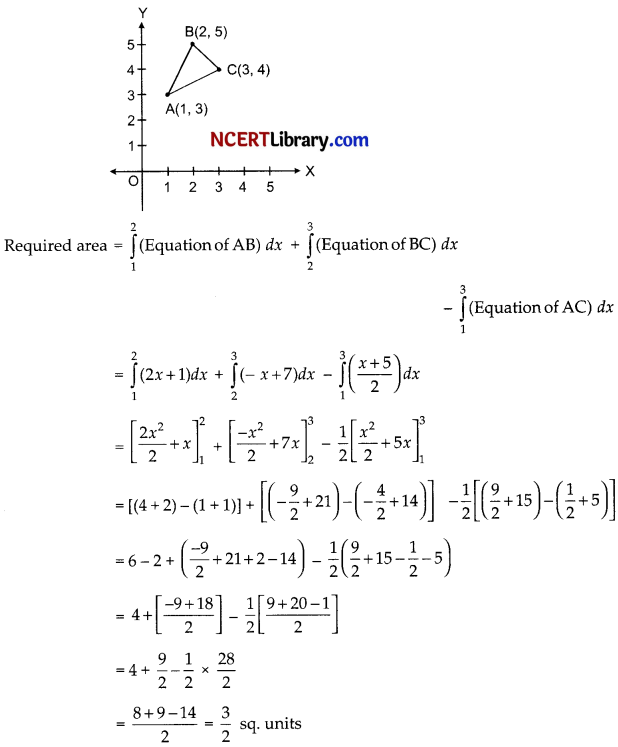
![]()
Question 33.
Prove the following: cos-1\(\frac { 12 }{ 13 }\) + sin-1\(\frac { 3 }{ 5 }\) = sin-1\(\frac { 56 }{ 65 }\)
OR
Express in the simplest form: tan-1 \(\frac { cosx – sinx }{ cos x + sin x }\)
Solution:
Let cos-1\(\frac { 12 }{ 13 }\) = x
sin-1\(\frac { 3 }{ 5 }\) = x
So, cos x = \(\frac { 12 }{ 13 }\)
and sin y = \(\frac { 3 }{ 5 }\)
∴ sin2 x = 1 – cos2 x
= 1 – (\(\frac { 12 }{ 13 }\))2 = 1 – \(\frac { 144 }{ 169 }\) = \(\frac { 25 }{ 169 }\)
∴ sin x = \(\frac { 5 }{ 13 }\)
⇒ cos2 y = 1 – sin2 y
= 1 – \(\frac { 9 }{ 25 }\) = \(\frac { 16 }{ 25 }\)
∴ cos y = \(\frac { 4 }{ 5 }\)
Now, sin (x + y) = sin x cos y + cos x sin y
= (\(\frac { 5 }{ 13 }\) x \(\frac { 4 }{ 5 }\)) + (\(\frac { 12 }{ 13 }\) x \(\frac { 3 }{ 5 }\))
= \(\frac { 20 }{ 65 }\) + \(\frac { 36 }{ 65 }\) = \(\frac { 56 }{ 65 }\)
x + y = sin-1 (\(\frac { 56 }{ 65 }\))
x = cos-1 (\(\frac { 12 }{ 13 }\))
y = sin-1 (\(\frac { 3 }{ 5 }\))
∴cos-1(\(\frac { 12 }{ 13 }\)) + sin-1(\(\frac { 3 }{ 5 }\)) = sin-1(\(\frac { 56 }{ 65 }\))
OR
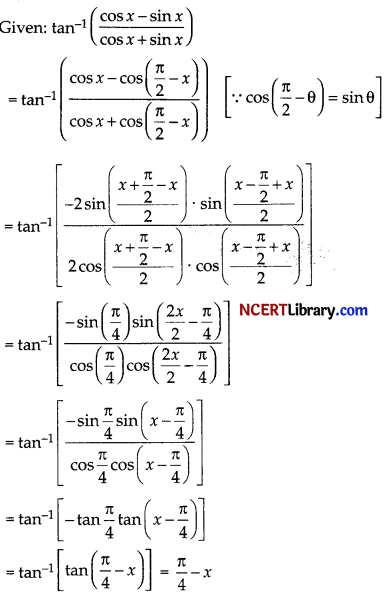
Question 34.
Find the equations of the two lines through the origin which intersect the line \(\frac { x – 3 }{ 2 }\) = \(\frac { y – 3 }{ 1 }\) = \(\frac { z }{ 1 }\) at an it angle of \(\frac { π }{ 2 }\).
OR
Write the vector equation of the following lines and hence find the distance between them:
\(\frac { x – 1 }{ 2 }\) = \(\frac { y – 2 }{ 3 }\) = \(\frac { z + 4 }{ 6 }\),\(\frac { x – 3 }{ 4 }\) = \(\frac { y – 3 }{ 6 }\) = \(\frac { z + 5 }{ 12 }\)
Solution:
The equation of given line is:
\(\frac { x – 3 }{ 2 }\) = \(\frac { y – 3 }{ 1 }\) = \(\frac { z + 0 }{ 1 }\) = λ (say) ……….(i)
Any point on the line (i) is:
P(2λ + 3, λ +3, λ)
Now, d.r.’s of OP are
(2λ + 3 – 0, λ + 3, λ)
i.e., 2λ + 3, λ + 3, λ
d.r.’s of line (i) are < 2, 1, 1>
Since, OP makes an angle of \(\frac { π }{ 3 }\) with (ii), we get
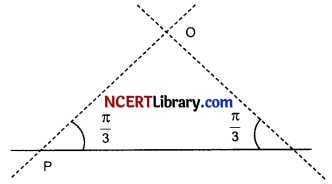
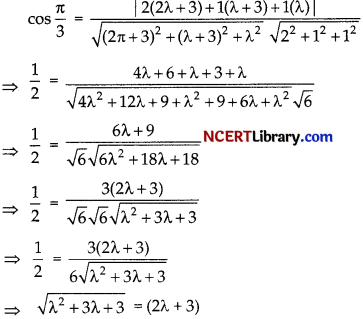
⇒ λ2 + 3λ + 3 = (2λ + 3)2
⇒ λ2 + 3λ + 3 = 4λ2 + 9 + 12λ
⇒ 3λ2 + 9λ + 6 = 0
⇒ λ2 + 3λ +2 = 0
⇒ λ = – 1 or – 2
Substituting these values of A, the two possible positions of P are (1, 2, – 1) and ( – 1, 1, – 2) Hence, the required lines are
\(\frac { x – 0 }{ 1 – 0 }\) = \(\frac { y – 0 }{ 2 – 0 }\) = \(\frac { z – 0 }{ – 1 – 0 }\)
and \(\frac { x – 0 }{ – 1 – 0 }\) = \(\frac { y – 0 }{ 1 – 0 }\) = \(\frac { z – 0 }{ – 2 – 0 }\)
i.e, \(\frac { x }{ 1 }\) = \(\frac { y }{ 2 }\) = \(\frac { z }{ -1 }\)
and \(\frac { x }{ – 1 }\) = \(\frac { y }{ 1 }\) = \(\frac { z }{ -2 }\)
∴\(\frac { x }{ 1 }\) = \(\frac { y }{ 2 }\) = \(\frac { z }{ -1 }\)
and \(\frac { x }{ – 1 }\) = \(\frac { y }{ 1 }\) = \(\frac { z }{ -2 }\) are the two lines through origin, which intersects the given line at angle of \(\frac { π }{ 3 }\).
OR
Given, equation of lines are
\(\frac { x – 1 }{ 2 }\) = \(\frac { y – 2 }{ 3 }\) = \(\frac { z + 4 }{ 6 }\)
and
\(\frac { x – 3 }{ 4 }\) = \(\frac { y – 3 }{ 6 }\) = \(\frac { z + 5 }{ 12 }\)
Now, the vector equation of lines are
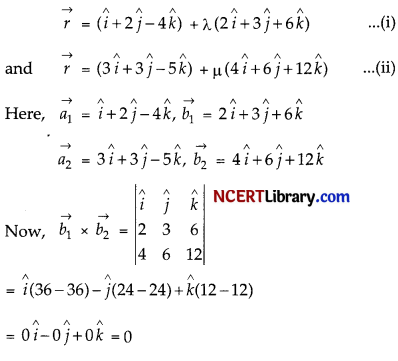
∵ \(\overrightarrow{b_1}\) x \(\overrightarrow{b_2}\) = 0
Vector b1 is parallel to b2. [∵ \(\vec{a}\) x \(\vec{b}\) = 0, then \(\vec{a}\) || \(\vec{b}\) ]
Therefore, the two lines are parallel
∴ \(\vec{b}\) = (2\(\hat{i}\) + 3\(\hat{j}\) + 6\(\hat{k}\)) ………..(iii)
[Since, d.r.’s of given lines are proportional]
Since, the two lines are parallel, we use the formula for shortest distance between two parallel lines.
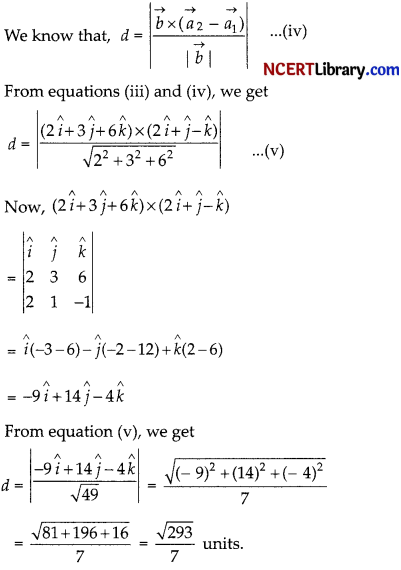
![]()
Question 35.
Determine the product

and use it to solve the system of equations:
x – y + z = 4; x – 2y – 2z = 9, 2x + y + 3z = 1
Solution:

Section – E
This section comprises of 3 case-study/passage-based questions of 4 marks each with two sub-parts. First two case study questions have three sub-parts (i), (ii), (iii) of marks 1, 1, 2 respectively. The third case study question has two sub-parts of 2 marks each.)
Question 36.
The order of a differential equation is the order of the highest derivative occuring in the differential equation. The degree of a differential equation whose terms are polynomials in the derivatives is defined as the highest power (positive integral index) of the highest order derivative in it.

(i) What is the product of the order and degree of the differential equation (\(\frac{d^2 y}{d x^2}\))2 – (\(\frac { dy }{ dx }\))3 = y
(ii) What are the number of arbitrary constants in the particular solution of a differential equation of second order?
(iii) If ni and n be the degree and order of the differential equation \(\left(1+y_1^2\right)^{2 / 3}\) = y2, then what is the value \(\frac { m + n }{ m – n }\) of ?
OR
What is the order and degree of the differential equation \(\frac{d^2 y}{d x^2}\) + (\(\frac { dy }{ dx }\))1/4 + x 1/5 = 0 ?
Solution:
(i) Here, Order 2, Degree 2
So, product is 4.
(ii) Particular solution of differential equation of any order, does not have any arbitrary constant.
(iii) We have \(\left(1+y_1^2\right)^{2 / 3}\) = y2
\(\left(1+y_1^2\right)^{2}\) = y2
Here Order (n) = 2, Degree (m) = 3.
So, \(\frac { m + n }{ m – n }\) = \(\frac { 3 + 2 }{ 3 – 2 }\)
= \(\frac { 5 }{ 1 }\) = 5.
OR
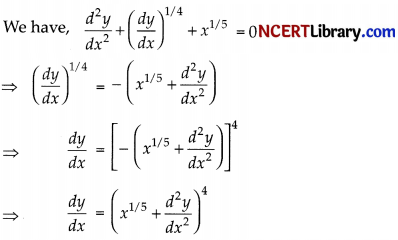
Here, the higher order derivative \(\frac{d^2 y}{d x^2}\), whose order is 2.
Also, the highest power of \(\frac{d^2 y}{d x^2}\) will be 4.
∴ Order = 2, Degree = 4.
Question 37.
Shreya wants to prepare a handmade gift box for her friend’s birthday at home for making lower part of the box. She takes a square piece of cardboard of side 20 cm.
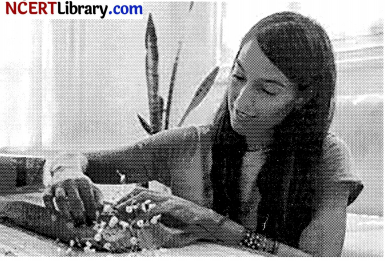
(i) If x cm be the length of each side of the square cardboard which is to be cut off from corners of the square piece of side 20 cm, then what is the possible value of x.
(ii) What is the volume of the open box founded by folding up the cutting corner (in terms of x)?
(iii) Find the value of x for which \(\frac { dV }{ dx }\) = 0?
OR
Shreya is interested in maximizing the volume of the box. So what should be the side of the square to he cut off so that the volume of the box is maximum?
Solution:
(i) Since, side of square is of length 20 cm, therefore x ∈ (0, 10).
(ii) Clearly, height of open box = x cm
length of open box = 20 – 2x
width of open box = 20 – 2x
∴ Volume (V) of the open box = x x (20 – 2x) (20 – 2x)
= x (20 – 2x)2
(iii) We have, V = x (20 – 2x)2
\(\frac { dV }{ dx }\) = 2x (20 – 2x)( – 2) + (20 – 2x)2
= (20 – 2x) ( – 4x + 20 – 2x)
= (20 – 2x) (20 – 6x)
Now
\(\frac { dV }{ dx }\) = 0
⇒ 20 – 2x = 0 or 20 – 6x = 0
x = 10 or \(\frac { 10 }{ 3 }\)
OR
We have, V = x (20 – 2x)2
\(\frac { dV }{ dx }\) = (20 – 2x)(20 – 6x)
\(\frac { dV }{ dx }\) = 0, x = 10, x = \(\frac { 10 }{ 3 }\)
\(\frac{d^2 \mathrm{~V}}{d x^2}\) = (20 – 2x)( – 6) + (20 – 6x)( – 2)
= – 2[60 – 6x + 20 – 6x]
=( – 2) (80 – 12x)
= 24x – 160
For x = \(\frac { 10 }{ 3 }\) ,\(\frac{d^2 \mathrm{~V}}{d x^2}\) < 0 For x = 10 ,\(\frac{d^2 \mathrm{~V}}{d x^2}\) > 0
![]()
Question 38.
A coach is training 3 players. He observes that the player A can hit the target 4 times in 5 shots, player B can hit the target 3 times in 4 shots and the player C can hit 2 times in 3 shots.
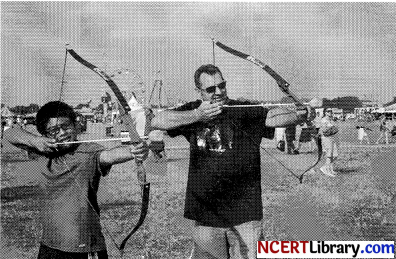
(i) Let the target be hit by A, 13 and C one by one, what is the probability that any two of A, B and C will hit?
(ii) What is the probability that at least one of A, B or C will hit the target?
P(A) = \(\frac { 4 }{ 5 }\), P(B) = \(\frac { 3 }{ 4 }\) P(C) = \(\frac { 2 }{ 3 }\)
Solution:
(i) Required probability = P(\(\bar{A}\))P(B)P(C) + P( A )P(\(\bar{B}\))P(C) + P(A)P(B)P(\(\bar{C}\))
